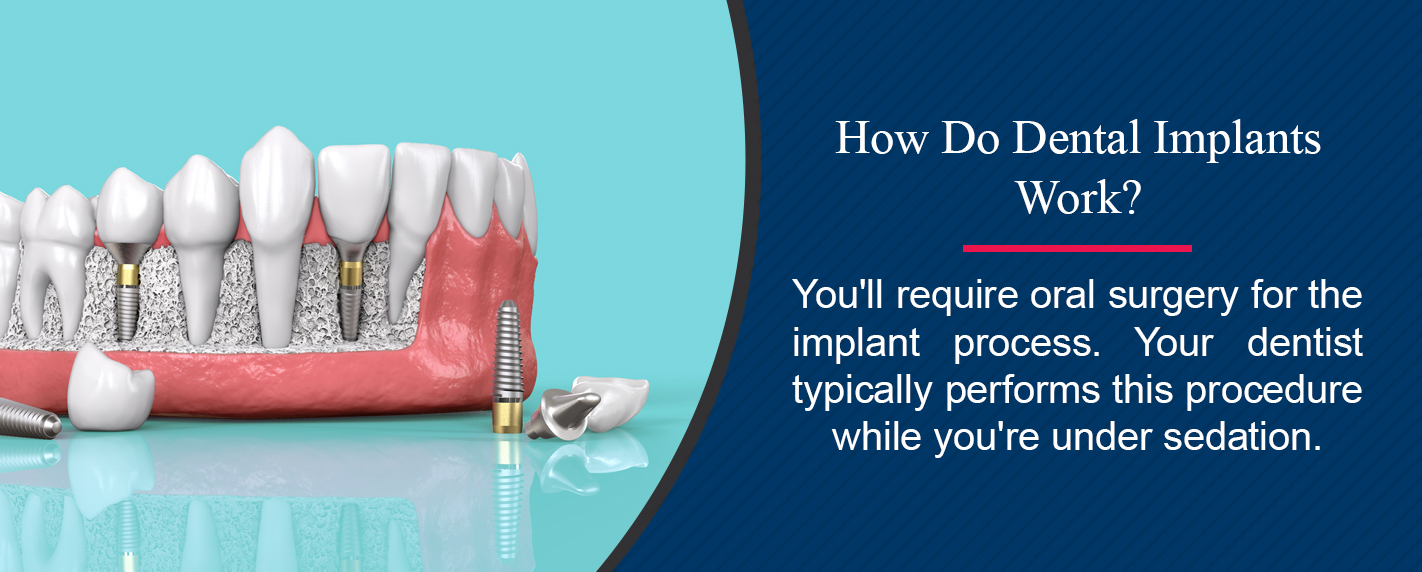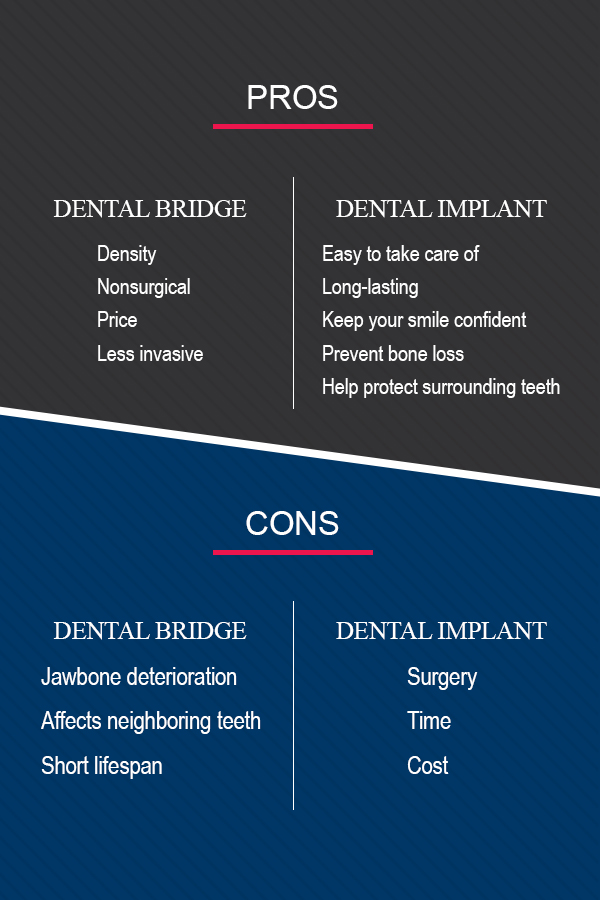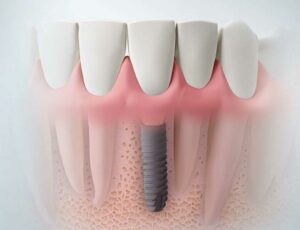“Should I get a bridge or implant?” That’s a common tooth replacement question many people ask themselves when it comes time for teeth replacements. Extracted or missing teeth can pose the risk of infection, but a quality replacement option is key to a healthy, beautiful smile. When it comes time to replace that missing tooth or teeth, your next question for your dentist will likely be, “What is the difference between a bridge and an implant?”
Let’s dive into that and go over considerations like types, aesthetics, cost, effectiveness, pros and cons and recovery outlook of both.
What Is a Dental Bridge?
In the past, the only option you had for a solution to a gap between teeth was a bridge. Today, people who have one or more missing teeth can still benefit from a dental bridge.
A dental bridge, as the name implies, literally “bridges” the space between teeth that results from a missing tooth. Therefore, the restoration needs anchoring to one or more neighboring teeth, which your dentist will have to file down so they can function as a support.
Bridges don’t replace your tooth root like implants. Instead, they use one or more of your surrounding teeth as a buttress for attaching a crown that fills the space of the missing tooth.
A dental bridge can replace between one and four teeth, depending on the patient’s needs. It can replace more than four teeth in some rare cases, but there must be enough healthy teeth present to connect the dental crowns.
Types of Dental Bridges
There are several types of dental bridges, including:
Traditional Dental Bridge
A traditional dental bridge is the most popular type of dental bridge. It uses false teeth held in place by dental crowns cemented to neighboring natural teeth. This option is an ideal choice when you have natural teeth on both sides of a missing tooth.
Cantilever Dental Bridge
A cantilever dental bridge uses a dental crown cemented to one neighboring tooth, so you only need one natural tooth next to the gap from the missing tooth.
Maryland Dental Bridge
Like a traditional bridge, a Maryland bridge requires two natural teeth, one on each side of the missing tooth gap. Instead of using dental crowns, a Maryland bridge uses a metal or porcelain framework bonded to the backs of the neighboring teeth.
Implant-Supported Dental Bridge
Implant-supported bridges use dental implants rather than crowns or frameworks. One implant is surgically placed for every missing tooth, and the implants hold the bridge in place.
Impact-supported bridges are typically considered the strongest and most stable bridge types. Placing an impact-supported bridge can take several months, as it requires two surgeries: one to embed the implants in the jawbone and one to place the bridge.
How Dental Bridges Work
During your first visit to a dental office to get a bridge, your dentist prepares the neighboring teeth. The preparation for this involves the dentist removing part of the enamel to recontour these teeth to allow room for the crown, which the dentist places over them.

Your dentist then takes impressions of the teeth to use as a model from which a dental technician will make the crowns, pontic and bridge in the lab. To protect your exposed gums and teeth while your bridge is under construction, the dentist will make you a temporary bridge.
Your dentist removes the temporary bridge during your second visit, and will check and adjust the new metal or porcelain bridge if necessary to ensure a proper fit. You may require multiple visits, so the dentist can check how the metal framework and bite fit. If you have a fixed bridge, the dentist might cement it temporarily in place for a couple of weeks to ensure it fits properly. They’ll then permanently cement the bridge after a couple of weeks.
How Dental Bridges Look
Like a dental veneer, a ceramic bridge can be attractive and largely unnoticeable. In some cases, the dentist might prefer a porcelain bridge over a dental implant, since it gives them more control over removing the small spaces between teeth that might not be aesthetically attractive if you have an implant.
How Long Will Dental Bridges Last?
The average lifespan of a bridge is around 10 years. A dental bridge involves at least three crowns attached to fill the missing tooth gap. However, this design can pose a challenge when it comes time to brush and floss, so the dentist will provide extra oral hygiene instructions.
If you follow the instructions carefully, you can keep your bridge clean and fresh and prolong its lifespan. Some dental bridge care tips are:
- Brush two times a day with toothpaste to help keep that dentist-clean feeling. Look for toothpaste that contains silica, which is what dentists use.
- Floss under the false tooth once daily and in between your natural teeth.
- Visit your dental hygienist or dentist regularly to have your teeth professionally cleaned.
- Consume a diet with more vegetables, fruits and fiber than meat.
Ask the dentist how you can care for your bridge if you’re not sure, and return to their office regularly so they can check your bridge.
Are Dental Bridges Permanent?
Part of your natural tooth is underneath the bridge, and normal wear could cause your bridge to fail over time. Your remaining tooth structure will continue to be vulnerable to gum disease and tooth decay.
Cost of Dental Bridges
Implant bridge cost is made up of numerous factors that can affect the price, including:
- How many teeth you require to fill the space
- Which materials the bridge involves, such as zirconia, composite resin or resin-covered metal alloy
- Your geographic location
- Additional treatments required for other dental problems like gum disease
- Difficulty/complexity of the bridge placement
The price also depends on which bridge type you choose.
Is a Dental Bridge Worth It?
A dental bridge replaces your missing teeth, restoring your ability to chew and speak properly. It also prevents your remaining teeth from shifting, which can cause bite problems. What’s more, a dental bridge reduces the risk of bone loss, maintaining your facial structure.
Can Teeth Decay Under a Bridge?
Natural teeth under the dental crowns in a bridge are vulnerable to tooth decay and other issues. Small pieces of food can get stuck between the teeth and a poorly fitted dental bridge, causing tooth decay. If your dental bridge is at the end of its lifespan, it may develop cracks in the cement holding it in place. Bacteria can enter through these cracks, infecting the underlying teeth. Poor dental hygiene can also lead to gum disease, causing problems for the teeth under the bridge.
Dental Implants
Dental implants are another solution for missing teeth. They’re an alternative option for many patients, and dental professionals often prefer them to dentures or even bridges.
What Are Dental Implants?
If you have periodontal disease, an injury or another reason for a lost tooth or teeth, dental implants might be your best choice. A dental implant supports a crown with a titanium post that acts like a tooth root.
Your dentist will place the implant surgically, then fuse it to your jawbone, thus anchoring it into position. Having completed the fusing process, the dentist attaches an abutment to the post frame, which protrudes above your gumline, providing a space to screw or cement the dental crown into.
How Do Dental Implants Work?
You’ll require oral surgery for the implant process. Your dentist typically performs this procedure while you’re under sedation.

During surgery, your dentist drills a small hole into your jawbone and screws the base carefully into your bone. They then place your gum over the dental implant so it can heal.
Once the implant base has healed efficiently, you’ll require a second surgery to fit a connector into the top of your dental implant. The dentist then will position the crown on top of this connector using a small screw and special dental cement.
Can you get an implant after a bridge? The answer is yes. Over time, a bridge can wear out and fail. It might not look as attractive as you hoped. Either way, you may wish to switch from a bridge to a dental implant to improve the aesthetics of your mouth.
How Implants Look
Often, dental implants will offer the most pleasing result, since the dentist can make them look like natural enamel. In some cases, they may place an implant immediately after they extract your tooth, which preserves the natural level of bone and improves the appearance of your dental work.
How Long Will Dental Implants Last?
Does a bridge or implant last longer? A dental implant is more durable than a bridge, which allows them to provide a lifetime of protection. The titanium metal cylinder of the implant is durable and incredibly resistant to gum problems and decay.
Caring for Dental Implants
Dental implants are easier to maintain than bridges. Implants can replace individual teeth while not affecting your other teeth, which makes routine home hygiene easier. To ensure the implant’s longevity, keep it clean and free of damaging plaque and bacteria that could cause gum tissue infection around your implant, leading to dental implant failure.
A slimy, thin film of bacteria called biofilm builds up in your mouth. When you don’t remove this, it can cause a damaging inflammatory process known as peri-implantitis to develop, resulting in implant loss.
Your dental hygienist plays a significant role in keeping your implants free of disease. If they use traditional dental hygiene scalers on your natural teeth, they can scratch an abutment, crown or implant. Therefore, the hygienist will use special tools made of resins and plastics instead to clean thoroughly without causing any damage.
You also have an essential role to play in the success of your implants, which should motivate you to care for them properly. At home:
- Use a soft-bristled toothbrush to clean at least two times a day.
- Brush around your implant crown and under it.
- Use a low-abrasive toothpaste.
- Use an oral irrigator.
- Clean places that are hard to reach using a nylon-coated interdental brush.
- Floss every day with implant-specific floss or unwaxed tape.
Preventing peri-implant disease is imperative to implant function and health, which is why an essential part of the success of your implant is how you care for it.
Cost of Dental Implants
It can cost you between $3,000 to $4,500 to replace a single tooth with a dental implant, depending on factors such as where you live.
Is an Implant Cheaper Than a Bridge?
The cost of implants is typically higher than bridges, especially if you need more than one.
Also, implants may require adjunctive procedures like a bone graft or sinus lift to increase the amount of bone supporting the implants, which adds to the cost.
Dental Bridges vs. Dental Implants
What is the difference between a bridge and an implant? Here’s a comparison of bridges and implants.
What Costs More: An Implant or a Bridge?
When it comes to bridgework vs. implants, individuals often use price as the deciding factor for their treatment option. And the cost can be deceiving in the case of dental bridges vs. implants.
Implants generally come at a higher cost than bridges, particularly if you require more than a single implant. Insurance usually covers dental bridges, but rarely implants.
The costs of dental bridges vary based on the type of bridge, the number of missing teeth, geographic location and more. Traditional bridges can range from $2,000 to $5,000.
If you don’t have dental insurance, you might choose the least expensive option, or you may consider signing up for a discount dental plan membership that offers discounted rates on these kinds of procedures.
What Does the Treatment Process Entail?
The procedure for a dental bridge doesn’t take as long as the dental implant process, which involves creating a direct functional and structural connection between a load-bearing artificial implant’s surface and living bone. However, it can still be more invasive, since it requires the permanent alteration of surrounding teeth for supporting the bridge.
Recovering From Your Dental Procedure
Your dentist can usually insert one implant in an hour or two, and the recovery time is relatively quick. Most individuals will feel good enough to return to work and other normal activities the next day. If you experience any discomfort after your procedure, over-the-counter pain medication should take care of it.
There’s also a short recovery time for a traditional bridge. You might experience some minor gum pain after the dentist cements your bridge into place. However, this typically goes away after several days. You might require a little time and adjustment in eating with the new dental bridge. You’ll want to avoid chewy or hard foods and cut softer foods into smaller pieces until you get used to it.
Following a dental bridge procedure, you should be able to chew and eat without issues, but you will need to change your dental care routine. See the American Dental Association post-procedure guidelines. No matter what type of bridge you have, you’ll have to clean under your false tooth to prevent tooth decay.
Is a Bridge Better Than an Implant?
When comparing dental bridges vs. dental implants, bridges are less durable. What lasts longer: a bridge, or an implant? Implants offer more extended protection — a lifetime. Bridges, on the other hand, have a lifespan of around 10 years. Implants also support jaw health. Your bone stays healthy and strong, which impacts both the shape of your face and oral health positively as you age. Implants naturally mimic the function and feel of a real tooth and often look better than bridges.
What Factors to Consider When Choosing Between a Dental Bridge and a Dental Implant
Consider these factors as you decide whether a dental bridge or a dental implant is best for you:
Cost: Dental insurance is usually more likely to cover a dental bridge than a dental implant.
Number of missing teeth: If you’re missing more than one consecutive tooth, a dental bridge may be the better option. Each implant must be surgically attached to your jawbone, making it more expensive and impractical in certain cases.
Overall health: The best implant candidates are in good health and have a strong jawbone. Dental implants require surgery, which may not be the best option for people with medical conditions that may affect the healing process.
Cost: Dental insurance is usually more likely to cover a dental bridge than a dental implant.
Number of missing teeth: If you’re missing more than one consecutive tooth, a dental bridge may be the better option. Each implant must be surgically attached to your jawbone, making it more expensive and impractical in certain cases.
Overall health: The best implant candidates are in good health and have a strong jawbone. Dental implants require surgery, which may not be the best option for people with medical conditions that may affect the healing process.
Bridge vs. Implant Pros and Cons
Let’s explore the strengths and weaknesses of dental bridges vs. implants.

Dental Bridge Pros
Here are some advantages of dental bridges.
- Density: Jawbone density is not a problem.
- Nonsurgical: You won’t require surgery.
- Price: It’s less costly.
- Less invasive: You can easily replace a tooth that has been missing for a while.
- Fast: Bridges are faster to place than implants.
Dental Bridge Cons
Here are some of the downsides of dental bridges.
- Jawbone deterioration: They don’t replace the root of your tooth, thereby causing the jawbone to degenerate more quickly.
- Affects neighboring teeth: The crowned teeth neighboring the space can be more vulnerable to decay. Placement of the bridge also requires the removal of significant parts of the teeth neighboring the missing tooth or teeth.
- Short lifespan: A bridge usually only lasts eight to 15 years before you will need to get it replaced.
Dental Implant Pros
Here are some advantages of dental implants.
- Easy to take care of: They require little maintenance.
- Long-lasting: When they’re high-quality, they can last a lifetime.
- Keep your smile confident: Dental implants are stable and secure. They feel, look and function like a natural tooth.
- Prevent bone loss: Not only do implants protect your jawbone, but they preserve and stimulate natural bone growth.
- Help protect surrounding teeth: They can stand on their own without having to put a strain on your other teeth.
Dental Implant Cons
Some of the downsides of dental implants are as follows.
- Surgery: Your dentist will have to surgically attach the implant to the bone. There are always risks involved with any surgical procedure, including success rate, nerve damage, infection, jaw fractures, damage to surrounding teeth and more.
- Time: You can’t get a dental implant in one office visit. Your bone takes time to heal, which means an entire implant procedure can take a few months.
- Cost: The cost varies depending on the condition of your tooth and the type of implant you receive. Even so, the higher price tag of an implant is often what holds people back from considering this procedure.
Contact Hiossen® Implant for More Information
For more information on bridges and implants, read our informational brochure. To learn more about which artificial teeth are better, reach out to us at Hiossen Implant by completing our online form or calling us at 888-678-0001. We specialize in providing effective, safe and simple-to-implement prosthetic products.





